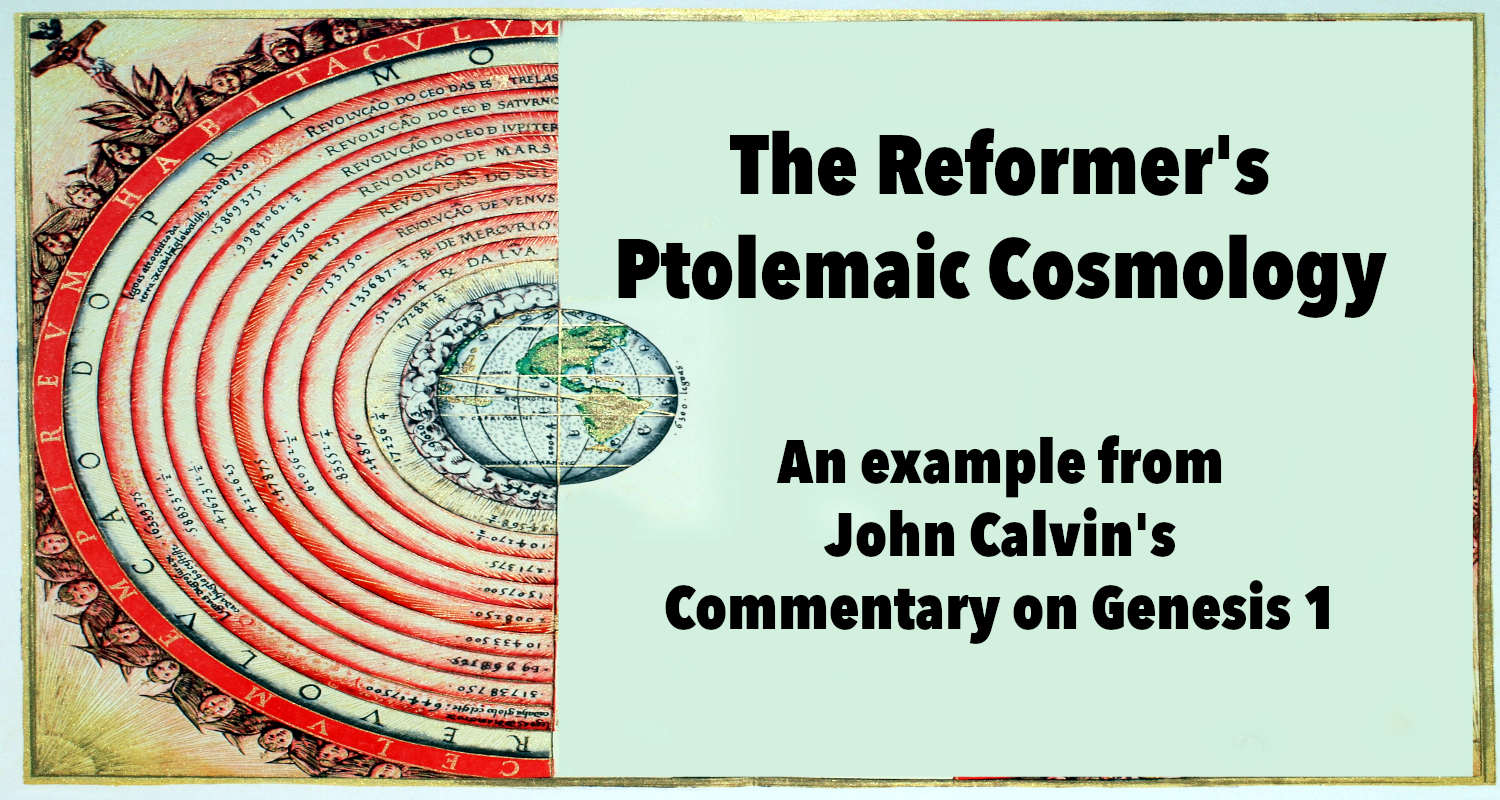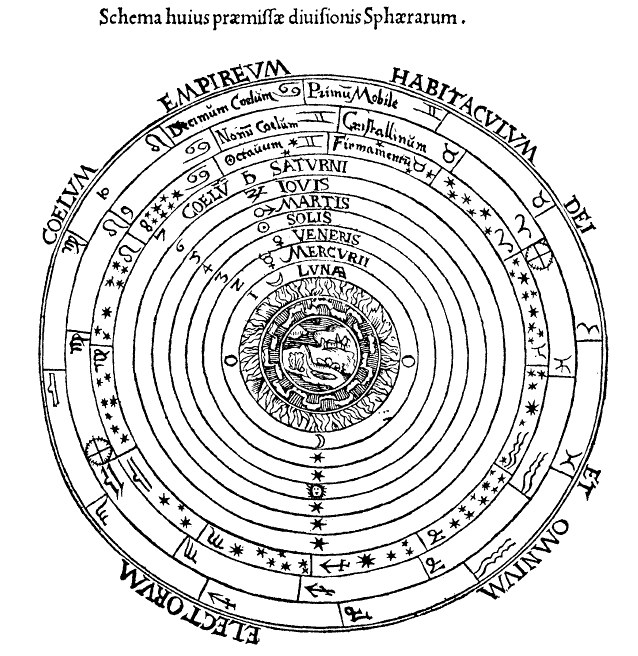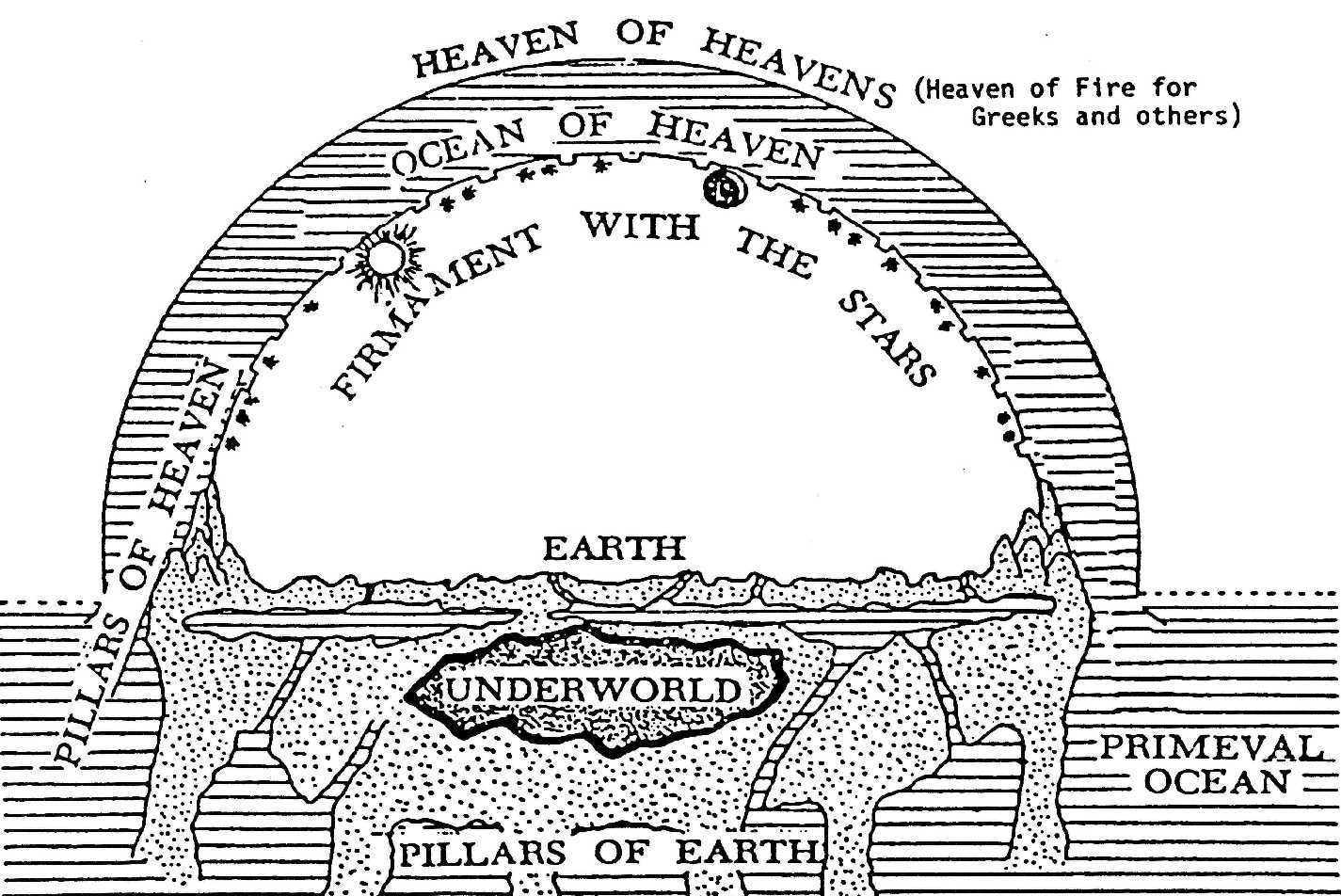
 John Calvin, Martin Luther and the other sixteenth century reformers held to a Ptolemaic cosmology, which placed the earth at the center of the universe, surrounded by about a dozen celestial spheres. The innermost spheres closest to earth correspond to the four elements (earth, water, air, and fire). The heaviest elements of earth and water formed the first spheres, and then above them were spheres of air and then of fire. Outside of the celestial spheres for the elements were spheres for the Moon, Mercury, Venus, the Sun, Mars, Jupiter, and Saturn that correspond to the gods. The outer most sphere consisted of the fifth element known as aether (or ether), and was a motionless celestial sphere where the stars were fixed (unlike the wandering stars (c.f. Jude 13) in the lower spheres, i.e. planets). The highest sphere was also known as the Empyrean (the highest heaven), beyond which was the dwelling place of God.
John Calvin, Martin Luther and the other sixteenth century reformers held to a Ptolemaic cosmology, which placed the earth at the center of the universe, surrounded by about a dozen celestial spheres. The innermost spheres closest to earth correspond to the four elements (earth, water, air, and fire). The heaviest elements of earth and water formed the first spheres, and then above them were spheres of air and then of fire. Outside of the celestial spheres for the elements were spheres for the Moon, Mercury, Venus, the Sun, Mars, Jupiter, and Saturn that correspond to the gods. The outer most sphere consisted of the fifth element known as aether (or ether), and was a motionless celestial sphere where the stars were fixed (unlike the wandering stars (c.f. Jude 13) in the lower spheres, i.e. planets). The highest sphere was also known as the Empyrean (the highest heaven), beyond which was the dwelling place of God.
Calvin's Ptolemaic Cosmology
In his Commentary on Genesis (1554), John Calvin interprets the fourth day of creation (Gen 1:13-18) entirely through Ptolemaic geocentricism. In his commentary on Genesis 1:15, Calvin argues that the Moon generates light to defend the author of Genesis (who Calvin identifies as Moses) that stated that the Moon is a great luminary (c.f. Gen 1:16). Calvin explains that the Moon moves through the fiery celestial sphere, so therefore it radiates light like the Sun and is not an opaque (i.e. dark body) that only reflects light. Calvin also admits that his explanation is refuted by the astronomers—likely a reference to Nicholas Copernicus' De revolutionibus orbium coelestium (1543).
For as it became a theologian, he [Moses] had respect to us rather than to the stars. Nor, in truth, was he ignorant of the fact, that the moon had not sufficient brightness to enlighten the earth, unless it borrowed from the sun; but he deemed it enough to declare what we all may plainly perceive, that the moon is a dispenser of light to us. That it is, as the astronomers assert, an opaque body, I allow to be true, while I deny it to be a dark body. For, first, since it is placed above the element of fire, it must of necessity be a fiery body. Hence it follows, that it is also luminous; but seeing that it has not light sufficient to penetrate to us, it borrows what is wanting from the sun. He calls it a lesser light by comparison; because the portion of light which it emits to us is small compared with the infinite splendor of the sun. [1]
In Calvin's commentary on Genesis 1:16, Calvin explicitly mentions the distinct celestial spheres and mentions that the stars are fixed in the firmament. Prior to the Copernican revolution, Christians identified the outer sphere of Ptolmaic's cosmology with the Biblical firmament (mentioned multiple times throughout the first creation story in Genesis 1). Calvin likewise interprets Genesis 1:14-15's statement about the stars in the firmament in concord with the stars in the celestial sphere of aether.
I have said, that Moses does not here subtilely descant, as a philosopher, on the secrets of nature, as may be seen in these words. First, he assigns a place in the expanse of heaven to the planets and stars; but astronomers make a distinction of spheres, and, at the same time, teach that the fixed stars have their proper place in the firmament. Moses makes two great luminaries; but astronomers prove, by conclusive reasons that the star of Saturn, which on account of its great distance, appears the least of all, is greater than the moon [2]
Additionally, Calvin explains the existence of the seasons according to the Ptolemaic system, that due to the Sun's eccentric orbit within its celestial sphere around the earth, the summer is caused by the sun's nearer approach to the earth (not due to the tilt of the earth's axis):
Under the term nature, I also comprise agriculture. For although sowing and reaping require human art and industry; this, nevertheless, is natural, that the sun, by its nearer approach, warms our earth, that he introduces the vernal season, that he is the cause of summer and autumn. But that, for the sake of assisting their memory, men number among themselves years and months; that of these, they form lustra and olympiads; [3]
Calvin's Hermeneutic of Accommodation
It's important to notice that John Calvin admits that the astronomers are correct that Saturn is a greater luminary than the Moon. The statement demonstrates that Calvin did not use Genesis to correct his scientific knowledge, and admits that the astronomers were correct and that Moses was wrong. (Calvin suggests that Moses is describing creation from an observers point of view, but he does not clearly admit these are observational errors.) Calvin explains that Moses did not intend to reveal scientific knowledge, but to help the uneducated person understand the world in accommodation to the reader's relative cosmology. Calvin argues that it would not be beneficial for Genesis to be written like a scientific thesis, because it would not be understandable to the common person.
Therefore, in order to apprehend the meaning of Moses, it is to no purpose to soar above the heavens; let us only open our eyes to behold this light which God enkindles for us in the earth. By this method (as I have before observed) the dishonesty of those men is sufficiently rebuked, who censure Moses for not speaking with greater exactness. [4]
Had he spoken of things generally unknown, the uneducated might have pleaded in excuse that such subjects were beyond their capacity. Lastly since the Spirit of God here opens a common school for all, it is not surprising that he should chiefly choose those subjects which would be intelligible to all. If the astronomer inquires respecting the actual dimensions of the stars, he will find the moon to be less than Saturn; but this is something abstruse, for to the sight it appears differently. Moses, therefore, rather adapts his discourse to common usage. [5]
There is therefore no reason why janglers should deride the unskillfulness of Moses in making the moon the second luminary; for he does not call us up into heaven, he only proposes things which lie open before our eyes. Let the astronomers possess their more exalted knowledge; but, in the meantime, they who perceive by the moon the splendor of night, are convicted by its use of perverse ingratitude unless they acknowledge the beneficence of God. [6]
The Reformers (including John Calvin and Martin Luther) were contemporaries of Nicolaus Copernicus and explicitly rejected his heliocentricism and condemned him for it. As the above commentary demonstrates, John Calvin was not opposed to scientific discoveries, and Calvin was willing to correct Genesis with more accurate astronomy. Unfortunately, like the Church has done many times throughout ages, the Reformers clung to their pre-Copernican systems and defective natural theology to their detriment. B. B. Warfield described John Calvin's method as a "prima facie chronology of the Biblical narrative" and also, "He enjoyed a joke hugely, with that open-mouthed laugh which, as one of his biographers phrases it, belonged to the men of the sixteenth century."
The Babylonian Cosmology of Genesis
 Theologians today agree that Genesis describes an Ancient Near East (ANE) cosmology that pre-dates the Ptolemaic cosmology and was shared by the ancient Sumerians and Babylonians. This ANE cosmology featured a nebulous plane of earth that was supported on top of an ocean by pillars, and had one celestial sphere (or firmament) where the Sun, moon, stars were placed, and another celestial ocean above the firmament. Calvin's Ptolemaic cosmology was a vast improvement over the ANE cosmology, and the New Testament also contains Ptolemaic cosmology (i.e. "wander stars" as planetary deities in Jude 13), but proved to be incorrect by Copernicus. The ANE cosmology demonstrates that Genesis was written in antiquity and so it should not be an embarrassing feature, but it's cosmology demonstrates the error of correcting modern astronomy or scientific knowledge with Genesis.
Theologians today agree that Genesis describes an Ancient Near East (ANE) cosmology that pre-dates the Ptolemaic cosmology and was shared by the ancient Sumerians and Babylonians. This ANE cosmology featured a nebulous plane of earth that was supported on top of an ocean by pillars, and had one celestial sphere (or firmament) where the Sun, moon, stars were placed, and another celestial ocean above the firmament. Calvin's Ptolemaic cosmology was a vast improvement over the ANE cosmology, and the New Testament also contains Ptolemaic cosmology (i.e. "wander stars" as planetary deities in Jude 13), but proved to be incorrect by Copernicus. The ANE cosmology demonstrates that Genesis was written in antiquity and so it should not be an embarrassing feature, but it's cosmology demonstrates the error of correcting modern astronomy or scientific knowledge with Genesis.
I highly recommend biologos as a resource for understanding how science and Genesis fit together, and to learn more about about the ancient near east cosmology of Genesis, I recommend John Walton's The Lost World of Genesis One: Ancient Cosmology and Origins Debate.
Sources:
1. John Calvin. Calvin's Commentaries Vol 1. : Commentary on Genesis (1554). trans. John King. Grand Rapids: Baker, 2003. [On Gen 1:15]
2. Calvin. Ibid. [On Gen 1:16]
3. Calvin. Ibid. [On Gen 1:14]
4. Calvin. Ibid. [On Gen 1:15]
5. Calvin. Ibid. [On Gen 1:16]
6. Calvin. Ibid. [On Gen 1:16]
7. Cosmology image sources: wikipedia.
Related: Accommodation, Accommodation to the Ordinary Custom of Men, astronomy, Commentary on Genesis, Copernicus, John Calvin, Martin Luther, Moses, Nicolaus Copernicus



November 29th, 2019 - 14:43
It seems to me that Calvin’s cosmology determined his Christology. How else to make sense of his insistence that Christ’s human nature is circumscribed in heaven and cannot be present to space or time; i.e. that it is only according to his divine nature that Christ “fills all things in every way” (Eph 1:23) even though in context these words are ascribed to the one God raised from the dead, that is, Christ according to his human nature. With this move Calvin set up Reformed theology to embrace the platonic divide of the humanists and the Cartesians thereafter.